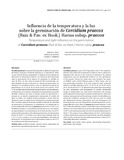| dc.rights.license | http://creativecommons.org/licenses/by-nc-sa/3.0/ve/ | |
| dc.contributor.author | Pece, Marta G. | |
| dc.contributor.author | Acosta, Marcia M. | |
| dc.contributor.author | Sobrero, Maria T. | |
| dc.date.accessioned | 2015-03-03T14:33:08Z | |
| dc.date.available | 2015-03-03T14:33:08Z | |
| dc.date.issued | 2015-03-03T14:33:08Z | |
| dc.identifier.issn | 0556-6606 | |
| dc.identifier.uri | http://www.saber.ula.ve/handle/123456789/39854 | |
| dc.description.abstract | Cercidium praecox forma parte de las grandes unidades de vegetación
del Parque Chaqueño Occidental Argentino y su importancia radica
en que coloniza terrenos degradados. El objetivo de este trabajo fue
determinar la temperatura óptima y la influencia del fotoperíodo
sobre la germinación de la especie. Se sembraron 25 semillas en
cajas de Petri con dos capas de papel de filtro humedecidas con
agua destilada, las que se colocaron en cámaras de germinación. Se
ensayaron en oscuridad continua como en alternancia lumínica las
temperaturas: 10, 15, 20, 25, 30, 35, 40, 45, 20/10, 25/15, 30/20 y 35/15
°C. Se consideró para el porcentaje de germinación, a la temperatura y
el fotoperiodo en un diseño completamente aleatorizado en parcelas
divididas, mientras que para el tiempo medio de germinación y
entropía en un diseño completamente aleatorizado. El análisis de
datos se realizó con modelos lineales generales y mixtos. Para las
diferencias entre las medias de los tratamientos se empleó la prueba
DGC. Se utilizó regresión lineal para modelar la relación de velocidad
de germinación y temperatura. La temperatura y el fotoperiodo no
actúan independientemente, C. praecox germina entre 15 y 40 °C y es
fotoblástica positiva. La velocidad de germinación tuvo una relación
de segundo grado con la temperatura, en el intervalo entre 15 y 40 °C,
produciéndose la máxima velocidad de germinación a la temperatura
teórica de 36,56 °C. El sistema se encuentra más ordenado entre 30
y 35 °C, lo que conduce a una alta germinabilidad y velocidad de
germinación, concluyéndose que la temperatura óptima es de 35 °C
en condiciones de alternancia lumínica. | es_VE |
| dc.language.iso | es | es_VE |
| dc.rights | info:eu-repo/semantics/openAccess | |
| dc.subject | Semillas forestales | es_VE |
| dc.subject | Especies nativas | es_VE |
| dc.subject | Temperatura de germinación | es_VE |
| dc.subject | Velocidad de germinación | es_VE |
| dc.subject | Entropía | es_VE |
| dc.title | Influencia de la temperatura y la luz sobre la germinación de Cercidium praecox (Ruiz & Pav. ex Hook.) Harms subsp. Praecox | es_VE |
| dc.title.alternative | Temperature and light influence on the germination of Cercidium praecox (Ruiz & Pav. ex Hook.) Harms subsp. Praecox | es_VE |
| dc.type | info:eu-repo/semantics/article | |
| dc.description.abstract1 | Cercidium praecox is part of the large plant units of the Argentine
Western Chaco Park and its importance resides in that it colonizes in
degraded soils. The aim of this work was to determine the optimal
temperature and the photoperiod influence on the germination
of this species. Twenty five seeds were sown between two layers
of distilled water wetted filtering paper in Petri’s boxes and set
into germinating chambers. They were tested for both continued
darkness and light alternation at 10, 15, 20, 25, 30, 35, 40, 45, 20/10,
25/15, 30/20 and 35/15 °C. To determine the germination percentage
for each temperature and photoperiod an entirely randomized
design in divided plots was used while to determine the average
germinating time and entropy an entirely randomized one. Data were
analyzed using general and mixed linear models. For the differences
among the treatment averages the DGC test was used. To model
the relationship between germination rate and temperature the
lineal regression was used. Temperature and photoperiod do not act
independently to each other; C. praecox germinates between 15 and
40 °C and is photoblastic positive. Germination rate and temperature
relates to each other following a second order relationship within the
15-40 °C interval being the peak rate at the theoretical temperature of
36.56 °C. The system is more orderly between 30-35 °C which leads to
a higher germinating capacity and germination rate that altogether
allows for the conclusion that the optimal temperature is that of 35 °C
under light alternation conditions. | es_VE |
| dc.description.colacion | 29-35 | es_VE |
| dc.description.email | mpece24@gmail.com | es_VE |
| dc.description.frecuencia | semestral | |
| dc.publisher.pais | Venezuela | es_VE |
| dc.subject.facultad | Facultad de Ciencias Forestales y Ambientales | es_VE |
| dc.subject.keywords | Forest seeds | es_VE |
| dc.subject.keywords | Native species | es_VE |
| dc.subject.keywords | Germinating temperature | es_VE |
| dc.subject.keywords | Germination rate | es_VE |
| dc.subject.keywords | Entropy | es_VE |
| dc.subject.publicacionelectronica | Revista Forestal Venezolana | |
| dc.subject.seccion | Revista Forestal Venezolana: Artículos | es_VE |
| dc.subject.thematiccategory | Geografía | es_VE |
| dc.subject.thematiccategory | Medio Ambiente | es_VE |
| dc.subject.tipo | Revistas | es_VE |
| dc.type.media | Texto | es_VE |


